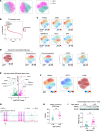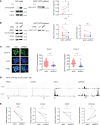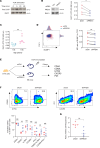PREX1 improves homeostatic proliferation to maintain a naive CD4+ T cell compartment in older age
- PMID: 38329813
- PMCID: PMC10972599
- DOI: 10.1172/jci.insight.172848
PREX1 improves homeostatic proliferation to maintain a naive CD4+ T cell compartment in older age
Abstract
The human adult immune system maintains normal T cell counts and compensates for T cell loss throughout life, mainly through peripheral homeostatic proliferation after the ability of the thymus to generate new T cells has rapidly declined at adolescence. This process is mainly driven by STAT5-activating cytokines, most importantly IL-7, and is very effective in maintaining a large naive CD4+ T cell compartment into older age. Here, we describe that naive CD4+ T cells undergo adaptations to optimize IL-7 responses by upregulating the guanine-nucleotide exchange factor PREX1 in older age. PREX1 promotes nuclear translocation of phosphorylated STAT5, thereby supporting homeostatic proliferation in response to IL-7. Through the same mechanism, increased expression of PREX1 also biases naive cells to differentiate into effector T cells. These findings are consistent with the concept that primarily beneficial adaptations during aging, i.e., improved homeostasis, account for unfavorable functions of the aged immune system, in this case biased differentiation.
Keywords: Adaptive immunity; Aging; Immunology; T cells.
Figures




Similar articles
-
Dual mechanism of impairment of interleukin-7 (IL-7) responses in human immunodeficiency virus infection: decreased IL-7 binding and abnormal activation of the JAK/STAT5 pathway.J Virol. 2010 Jan;84(1):96-108. doi: 10.1128/JVI.01475-09. J Virol. 2010. PMID: 19864382 Free PMC article.
-
IL-7/STAT5 cytokine signaling pathway is essential but insufficient for maintenance of naive CD4 T cell survival in peripheral lymphoid organs.J Immunol. 2007 Jan 1;178(1):262-70. doi: 10.4049/jimmunol.178.1.262. J Immunol. 2007. PMID: 17182563
-
Altered responses to homeostatic cytokines in patients with idiopathic CD4 lymphocytopenia.PLoS One. 2013;8(1):e55570. doi: 10.1371/journal.pone.0055570. Epub 2013 Jan 30. PLoS One. 2013. PMID: 23383227 Free PMC article.
-
Cytokine synergy in antigen-independent activation and priming of naive CD8+ T lymphocytes.Crit Rev Immunol. 2009;29(3):219-39. doi: 10.1615/critrevimmunol.v29.i3.30. Crit Rev Immunol. 2009. PMID: 19538136 Review.
-
Generation and maintenance of memory CD4(+) T Cells.Curr Opin Immunol. 2009 Apr;21(2):167-72. doi: 10.1016/j.coi.2009.02.005. Epub 2009 Mar 11. Curr Opin Immunol. 2009. PMID: 19282163 Free PMC article. Review.
References
MeSH terms
Substances
Grants and funding
LinkOut - more resources
Full Text Sources
Research Materials
Miscellaneous

